Input interpretation

chlorotrifluoromethane
Chemical names and formulas
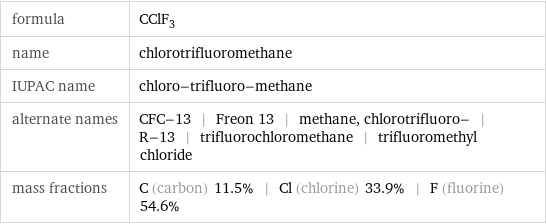
formula | CClF_3 name | chlorotrifluoromethane IUPAC name | chloro-trifluoro-methane alternate names | CFC-13 | Freon 13 | methane, chlorotrifluoro- | R-13 | trifluorochloromethane | trifluoromethyl chloride mass fractions | C (carbon) 11.5% | Cl (chlorine) 33.9% | F (fluorine) 54.6%
Lewis structure
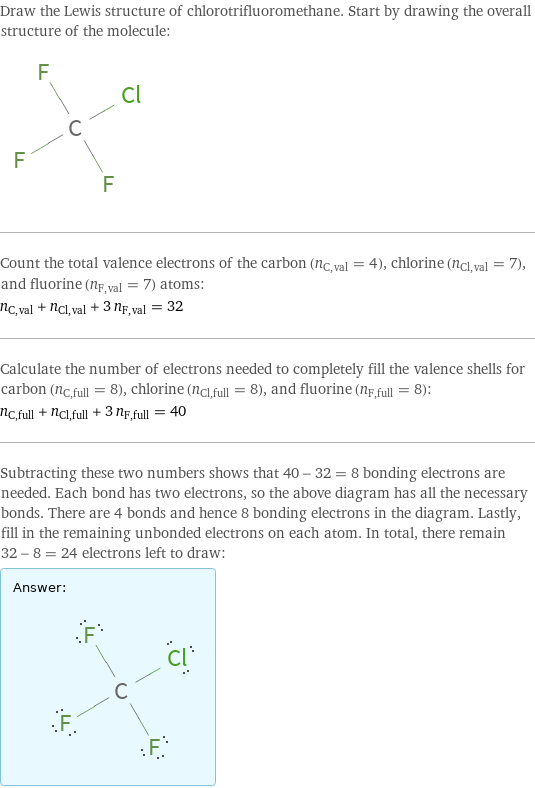
Draw the Lewis structure of chlorotrifluoromethane. Start by drawing the overall structure of the molecule: Count the total valence electrons of the carbon (n_C, val = 4), chlorine (n_Cl, val = 7), and fluorine (n_F, val = 7) atoms: n_C, val + n_Cl, val + 3 n_F, val = 32 Calculate the number of electrons needed to completely fill the valence shells for carbon (n_C, full = 8), chlorine (n_Cl, full = 8), and fluorine (n_F, full = 8): n_C, full + n_Cl, full + 3 n_F, full = 40 Subtracting these two numbers shows that 40 - 32 = 8 bonding electrons are needed. Each bond has two electrons, so the above diagram has all the necessary bonds. There are 4 bonds and hence 8 bonding electrons in the diagram. Lastly, fill in the remaining unbonded electrons on each atom. In total, there remain 32 - 8 = 24 electrons left to draw: Answer: | |
3D structure

3D structure
Basic properties

molar mass | 104.5 g/mol phase | gas (at STP) melting point | -181 °C boiling point | -81.4 °C density | 1.3 g/cm^3 (at 20 °C) solubility in water | insoluble dielectric constant | 2.32
Gas properties (at STP)
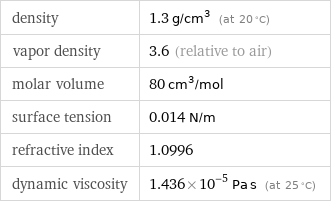
density | 1.3 g/cm^3 (at 20 °C) vapor density | 3.6 (relative to air) molar volume | 80 cm^3/mol surface tension | 0.014 N/m refractive index | 1.0996 dynamic viscosity | 1.436×10^-5 Pa s (at 25 °C)
Units

Thermodynamic properties

specific heat capacity c_p | gas | 0.6405 J/(g K) molar heat capacity c_p | gas | 66.9 J/(mol K) specific heat of formation Δ_fH° | gas | -6.762 kJ/g molar heat of formation Δ_fH° | gas | -706.3 kJ/mol molar heat of vaporization | 67.91 kJ/mol | specific heat of vaporization | 0.6501 kJ/g | critical temperature | 300 K | critical pressure | 3.921 MPa | (at STP)
Phase diagram

Phase diagram
Units

Chemical identifiers
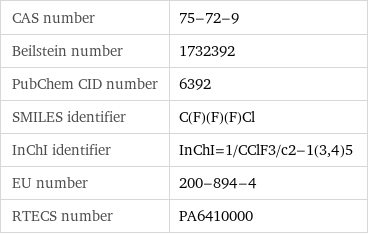
CAS number | 75-72-9 Beilstein number | 1732392 PubChem CID number | 6392 SMILES identifier | C(F)(F)(F)Cl InChI identifier | InChI=1/CClF3/c2-1(3, 4)5 EU number | 200-894-4 RTECS number | PA6410000
NFPA label

NFPA label
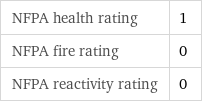
NFPA health rating | 1 NFPA fire rating | 0 NFPA reactivity rating | 0
Toxicity properties

RTECS classes | other